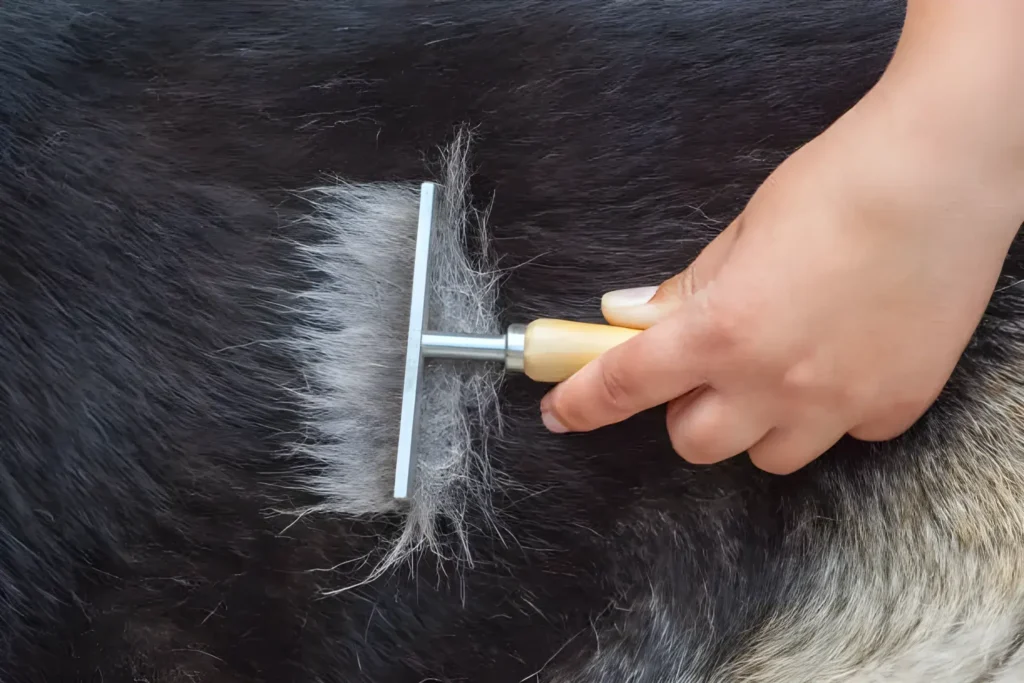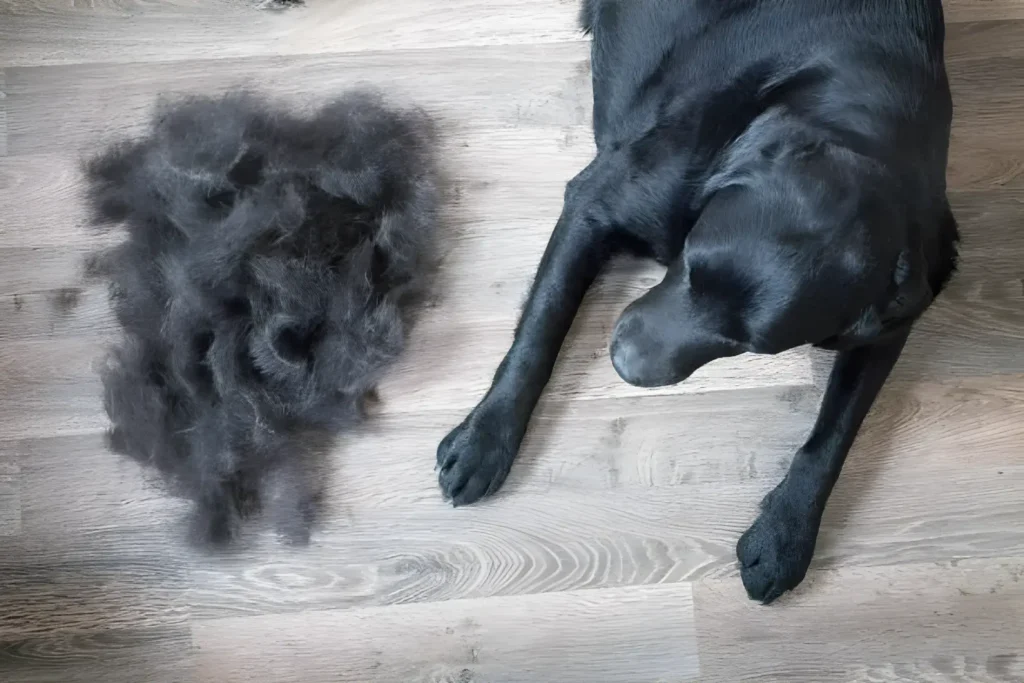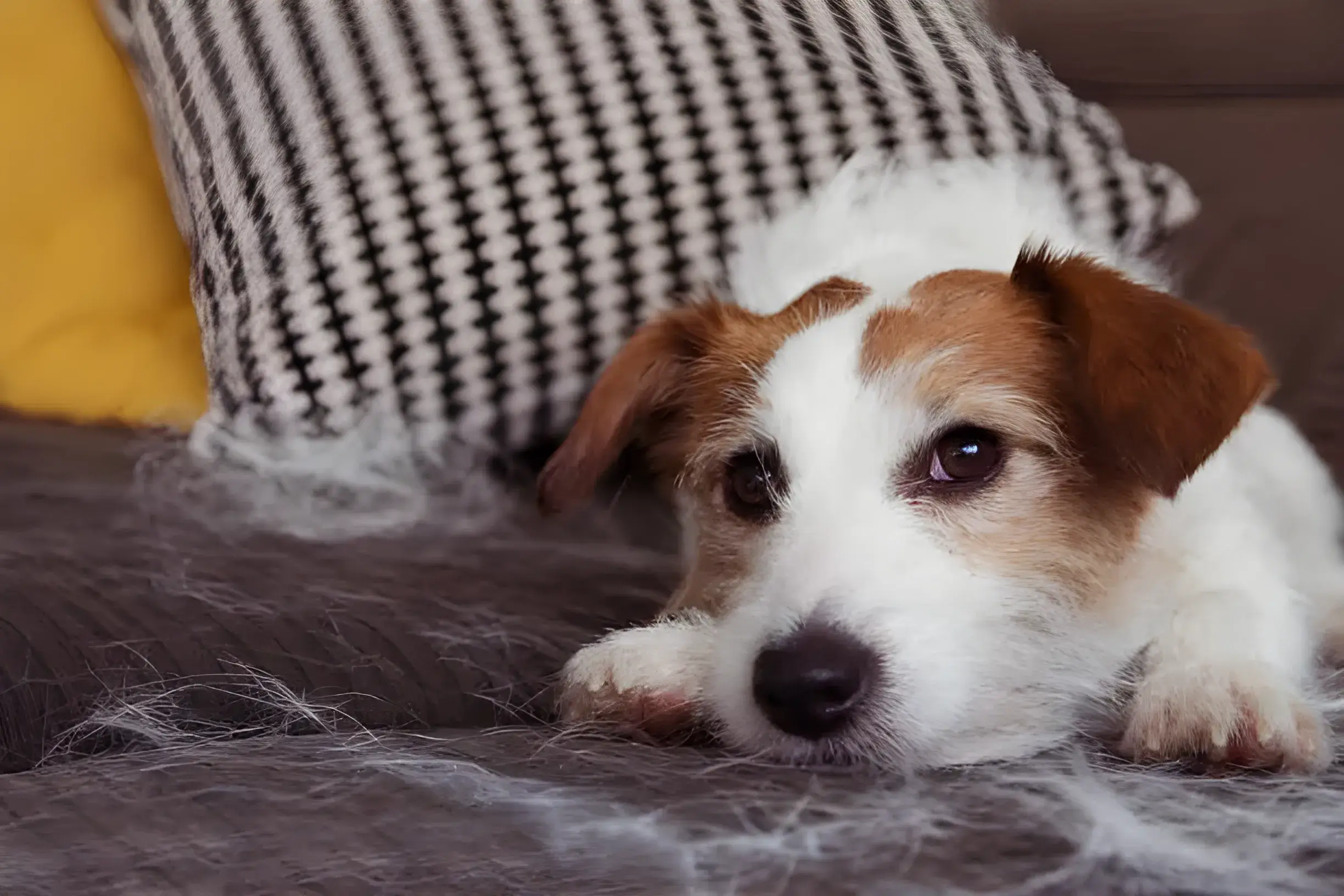You might think short-haired dogs leave minimal mess, but many shed just as much (or even more) than their fluffy counterparts. If you’re constantly finding fur despite your dog’s short coat, don’t worry! Here’s why short-haired dogs shed and what you can do to manage the furry frenzy.
Why Do Short-Haired Dogs Shed?
Seasonal Changes: Many short-haired dogs possess what’s called a double coat – a soft, fluffy undercoat for warmth, covered by a coarser layer of top fur. When the weather shifts, they shed heavily (“blowing coat”) to replace the undercoat for either lighter summer comfort or thicker winter protection.
Breed Variations: Certain short-haired breeds, such as Pugs, Beagles, Boxers, Labs, and German Shepherds, are simply wired to shed more than others. However, even within the same breed, some dogs shed heavily while others seem hardly to drop a hair! This can depend on their age, spay/neuter status, and overall health.
Health Concerns: Allergies (food or environmental), fleas or other parasites, stress, and medical conditions can all cause a dog to shed excessively. If you notice unusually heavy shedding, along with skin irritation or bald patches, it’s wise to schedule a vet checkup. Common culprits include hormonal imbalances like hypothyroidism and various skin infections.
Myth vs. Fact: Shedding Showdown
Myth: Short-haired dogs shed less than long-haired dogs.
- Fact: Shedding depends more on the type of coat (single vs. double) than on fur length. Many short-haired breeds have double coats, leading to heavy seasonal shedding. Single-coated breeds like Poodles, Italian Greyhounds, and Whippets do tend to shed minimally year-round.
Myth: Shaving a double-coated dog helps them stay cool in summer.
- Fact: A double coat acts as natural insulation, helping dogs regulate their temperature in both warm and cool conditions. Shaving disrupts this process, leaving them more susceptible to overheating, sunburn, and can even cause issues with proper coat regrowth. Regular brushing is a far more effective way to help them stay comfortable in the heat.
Combatting Short-Haired Dog Shedding
Your Fur-Fighting Toolkit
- The Versatile Bristle Brush: Use a softer version for daily maintenance, removing loose fur and distributing natural oils. Switch to a firmer bristled brush during those epic shedding periods to really target the undercoat.
- Your Dog’s Shedding Solution: Deshedding tools (the Furminator is a favorite among dog owners) make tackling loose undercoat a breeze, leaving your dog’s coat smooth and comfortable.
- Bathtime Buddy – The Rubber Curry: This gentle massaging brush is a bathtime favorite. It dislodges dead hair while naturally stimulating oil glands, leaving your dog’s coat shiny and healthy.
Strategic Bathing for Shed Control: Regular baths (roughly every 4-8 weeks) help release trapped undercoat and keep your dog’s coat in top condition. Look for a shedding-control shampoo with bonus ingredients like omega-3 fatty acids, which give an added boost to skin and coat. Note: Don’t overdo it, as too-frequent bathing can dry out the skin.
Feed for a Healthy Coat: What goes in reflects on the outside! A diet rich in premium protein and omega-3s (from sources like fish oil and flaxseed) supports healthy skin and a strong coat, potentially lessening those shedding episodes.
Beyond Grooming: Managing Shedding at Home

Furniture Covers: Save your sanity with washable covers for couches, beds, and other furniture favorites. Choose fabrics like microfiber or denim for easy fur removal.
Lint Rollers: Your new best friend! Keep lint rollers handy near the door, in your car, and at work for quick touch-ups on your clothing.
Air Purifier: An air purifier helps trap airborne fur and reduce allergens, benefiting both you and your dog, especially if anyone in the household suffers from pet allergies.
Robot Vacuum: A hands-free way to tackle those fuzzy tumbleweeds. Look for robotic vacuums specifically designed for pet hair for optimal fur removal.
When Shedding Is Excessive
Veterinarian Consult: If your dog’s shedding seems unusually heavy or is accompanied by symptoms like bald patches, skin irritation, or changes in behavior, a trip to the vet is crucial. They can rule out underlying health issues like allergies, thyroid problems, or other conditions that may be causing excessive shedding.
Professional Grooming: A groomer can perform thorough deshedding treatments using specialized tools and techniques. They can also offer breed-specific advice and spot any potential skin or coat issues that may be contributing to the problem.
Embracing the Fuzz (and Setting Realistic Expectations)
It’s important to remember that all dogs shed to some degree. While the techniques above will significantly decrease shedding, don’t expect to eliminate it completely. If you have an aversion to dog fur, a short-haired breed may not be the best fit for you.
Breed-Specific Spotlight: Short-haired Shedders

Boxers: Energetic and playful, but known for heavy shedding. Regular brushing with a bristle brush and deshedding tool is key.
Beagles: These friendly scent hounds have a double coat and require frequent brushing, especially during shedding seasons.
Pugs: Adorable with minimal grooming needs, but their wrinkled skin traps loose fur. Regular wipes and attention to skin folds are important.
Labrador Retrievers: Popular family dogs, Labs shed year-round. A combination of bristle brush and rubber curry brush is ideal.
Ask the Groomer
How often should I bathe my short-haired dog to control shedding?
Frequent baths can dry out your dog’s skin and worsen shedding. Every 4-8 weeks is sufficient. Use a gentle, shedding-control shampoo.
Are there any grooming tools you recommend for short-haired dogs?
A good quality deshedding tool is a game-changer. Look for one designed for short fur. For daily brushing, a bristle brush works well.
Personal Anecdote: My Life with a Short-Haired Shedder
My Beagle, Buster, sheds like a champion. At first, the fur tumbleweeds were overwhelming. But with a consistent grooming routine (including daily brushing during shedding season) and some strategic home hacks (like furniture covers and a good robot vacuum), we’ve learned to live in harmony with the hair. The occasional lint roller pass is still essential, but the love and joy Buster brings is worth every fuzzy sock!
Conclusion
Managing short-haired dog shedding takes dedicated effort, but the rewards are well worth it. With the right grooming tools, healthy habits, and some home adjustments, you can enjoy your short-haired companion without drowning in a sea of fur.
The photo featured below the post headline is Credit: smrm1977/istockphoto
I hope you find this post helpful and informative. If Yes’ feel free to share it with your friends!
Frequently Asked Question
How often should I brush my short-haired dog?
Regular brushing 2-3 times a week is ideal. During shedding seasons, increase to daily brushing.
Are there any supplements to help with shedding?
Omega-3 fatty acid supplements may promote skin and coat health, potentially leading to less excessive shedding over time. However, it’s crucial to consult your veterinarian before introducing any supplements to your dog’s routine.
My short-haired dog is shedding excessively. What should I do?
If shedding seems extreme, consulting your vet is the best course of action to identify any underlying health concerns.
Is there a short-haired dog that doesn’t shed?
While no dog is completely shed-free, breeds like the Basenji, Italian Greyhound, and Whippet are known for minimal shedding. However, even these breeds shed some hair.
Do short-haired dogs need professional grooming?
While their grooming needs are generally less intensive than long-haired breeds, short-haired dogs benefit from professional deshedding treatments during heavy shedding periods.
Can I shave my double-coated short-haired dog to reduce shedding?
No, shaving a double-coated dog disrupts its natural temperature regulation and can lead to fur regrowth issues. Deshedding treatments and regular brushing are better solutions.
Does my short-haired dog need a special diet to help with shedding?
Focusing on a balanced diet with quality protein sources and omega-3 fatty acids supports healthy skin and coat, which is essential for any dog. This can contribute to a healthier shedding process overall.
Are there any home remedies for short-haired dog shedding?
While a healthy diet and consistent grooming are your most powerful tools, some owners find a small amount of olive or coconut oil added to their dog’s meals may promote skin health. This could have a mild, indirect benefit for shedding. However, it’s essential to consult your veterinarian before adding anything new to your dog’s diet or trying any home remedies.
How can I reduce dog fur on furniture and carpets?
Furniture covers, strategic use of throws, lint rollers, a robot vacuum, and regular deep cleaning of carpets will help you win the battle against fur accumulation.
Can allergies make my short-haired dog shed more?
Yes, allergies can cause skin irritation and inflammation, leading to increased shedding in both short- and long-haired dogs. Consult your vet if you suspect allergies.
Will deShedding my short-haired dog stop the shedding completely?
Deshedding significantly reduces shedding but it won’t eliminate it entirely. All dogs shed to some degree.

